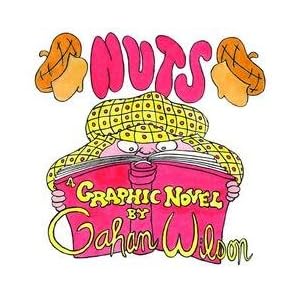
When I was in high school, I really reaped the benefits of whomever had been there before me and encouraged the librarians to stock the humor shelves with some great cartoons and comics. Not only did I discover Jack Ziegler then, but also Gahan Wilson, through the old paperback collection of Nuts. This was a monthly black-and-white strip, usually a single page, that appeared in National Lampoon.
The author's bio on that book led me back to my father's Playboy collection. I won't deny that for three or four years, I'd been reading his girlie magazines, but, unsurprisingly, I was just going from pictorial to centerfold pictorial to the third pictorial and then to the mostly-not-funny Playboy Funnies and then Little Annie Fanny. I'd long ago established that the other single-page comics in Playboy weren't worth my time, but I had never noticed Wilson's monthly page. I suppose that the next evening my folks were out, I probably went down to the basement and found the Wilson page in every one of about seven years' worth of magazines, and went back upstairs knowing that I had another fifteen years' more to find. Whenever it was I got that chance, I remember roaring with laughter over Wilson's iconoclastic, rule-breaking, macabre comedy. It made me a fan for life.
(The process of reading Oh! Wicked Wanda in Penthouse, which I still contend was one of the best comics of the '70s and badly needs to be reprinted was similar, except that Dad had a far smaller run of that magazine, and, unlike Playboy, the skanky pictorials in its pages prompted me to flip past them as quickly as possible. Point being, between Wanda and Wilson and PMOY 1981 Terri Welles, I'm not sure which I enjoyed the most even at age fourteen.)
But Nuts was just this really weird thing. I couldn't tell where it came from, since I only knew the name National Lampoon as appearing as part of the title of R-rated comedies on HBO, and had no idea then that there was a magazine. Logically, I figured that it had to come from somewhere, but even the reference within the author's bio in that book just made me think that Wilson had done some production work for Animal House or something. It was a terrific strip, even though I did not make the connection between it and Peanuts for years and years. As Schulz's strip was an idealized reflection of suburban, small town youth, Wilson's is a really more honest look back at childhood, full of complicated disappointments and the inability to understand grown-ups, illnesses, death, or cities. "The Kid," who mostly keeps his green hat on, is lost inside layers of jackets and coats, and buried under word balloons, insulated from the world as much as a child can try for.
It's certainly a very good strip, although, truly, it doesn't quite captivate me as much today as it did when I discovered it, and it was this completely left-field life event, showing a style of comics I'd never seen before. Other than the sex comics in Dad's magazines, the only other real comics-for-older-readers that I'd seen were probably The Freak Brothers, which had troubled my just-say-no self quite badly, so I didn't know what the heck this was. Nuts can't carry the shock of the new, in other words, now that I recognize it as both a reaction to Peanuts and heavily influenced by Robert Crumb.
And sometimes it is very frustrating. Working in his small grid of panels, Wilson's lettering really does overwhelm his art. Reading Fantagraphics' new hardback collection, which is said to reprint every one of the strips, I began resenting the standard text-only first panel of each comic, as it never really adds much to the story. In time, I caught myself skipping past it.
The dialogue is always important - the profanity-laden episode in which The Kid attempts to become an escape artist absolutely had me roaring with the accuracy of how children really think when they are frantic and very angry - but it becomes irritating when Wilson comes to a panel with just a hint of artwork escaping from underneath a balloon. That's a fair complaint, I think, because his artwork is so incredibly evocative and perfect when he gives it room to shine. There are several unforgettable, perfect panels with The Kid's face bunched up in jealous fury, the lines so small and tight and controlled that, even if it's a close-up on his face, or if there's room beneath the balloon for nothing more than the face, you can still see The Kid's fists somewhere out of the frame and your sight line, clenched in impotent rage, tiny little lines bringing to life every pulsing vein.
I bought a copy of the paperback a few years ago, but only thumbed through it once. I've owned a few thousands of books in my time, and I've never actually seen one where the binding has deteriorated quite like this one has, with the spine's glue disintegrating and transmogrifying into something like sawdust. Afraid of what I might do to it, or what air might do to it, I bagged and filed it, so I'm glad that Fantagraphics has brought this new edition out. Today, I fear that it's my dissatisfaction that might keep Nuts on the shelf, but I'm sure I'll rediscover it in time. The book looks just great, even if I would quibble with the designer's very odd choice to call this a "graphic novel" on the front cover, and while something about it honestly lacks the genuine, timeless brilliance of Wilson's decades of Playboy comics, this is still an important and very readable collection. After all, I'd never have gone looking for the Playboy comics in the first place if it weren't for Nuts! Recommended.
No comments:
Post a Comment